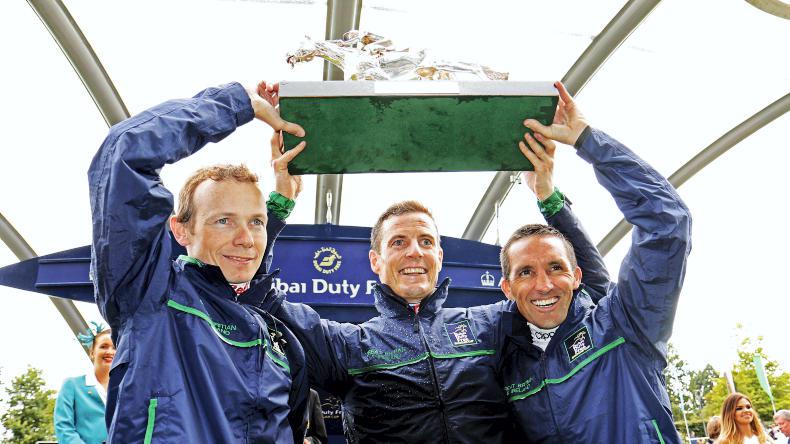JUST over two weeks ago the second item on the RTÉ Radio 1 sports bulletin during Morning Ireland related to Rachael Blackmore’s sustained push for top honours in the National Hunt jockeys’ championship.
The previous afternoon at Thurles the rider had notched up a double which enabled her to draw level with Paul Townend at the head of the jockey’s championship. In the overall context of the season the action at Thurles was of a generally low key variety but the campaign being enjoyed by Rachael Blackmore is nothing short of stunning.
She deserves each and every plaudit that comes her way and her continued success is providing a tremendous narrative to the National Hunt season in Ireland. Furthermore, it is supplying racing with the sort of profile and wider attention that the sport craves and long may this continue.
Sometimes in its insecurities racing can forget that much of its appeal rests with its participants both equine and human.
The ability to achieve the extraordinary, the unexpected and the brilliant are qualities which enable the sport’s participants to transcend the traditional confines of what would have been called the ‘racing pages’ in a pre-digital era.
CHAMPIONSHIP HORSE RACING
With this in mind it is hard not to view the mooted Championship Horse Racing format with a fair degree of scepticism. The proposed workings of The Series are that it will comprise of 12 teams each having a squad of 30 horses which may be in the care of a single trainer or multiple trainers.
These teams, which will also contain four jockeys and a racing manager, will compete in eight fixtures of six races staged on consecutive Thursday evenings from July to September.
It is planned that each team will have one runner in each of the 48 races and points will be awarded on a basis similar to that used in Formula 1. It is proposed that these races will be worth £100,000 each and in terms of Irish interest one of the eight courses due to be involved is Leopardstown.
Straight away there is an issue here with the concept of teams in racing lest we forget that team tactics are contrary to the rules of racing.
To take a trip down memory lane, the 2002 staging of the Shergar Cup was dogged by controversy surrounding the suggestion of the team tactics that enabled the team of Great Britain and Ireland to carry the day.
Quite how the organisers of The Series are going to sell the team thing in a sport where the word team starts ringing alarm bells remains to be seen.
There is no doubt that racing can be slow to change and even slower to warm to innovative thinking but this concept just doesn’t seem to offer the prospect of a compelling storyline and instead feels like an elongated version of the first incarnation of the Shergar Cup.
Lest our memory fail us, consider the premise for the initial Shergar Cup which was staged at Goodwood in early May in 1999. Back then the competition was a six-race event which took its inspiration from the Ryder Cup and pitted two teams against each other.
In 1999 there was the team from Europe, captained by the late Robert Sangster, taking on the Sheikh Mohammed-captained Middle East team.
The first staging of this competition was actually quite interesting and it attracted some high class horses across its six races.
Aidan O’Brien ran the previous year’s Phoenix Stakes winner Lavery, the subsequent dual Group 1-winning sprinter Diktat was another winner on the card. Others to compete included the high class international campaigner Running Stag and the previous year’s Epsom Derby third Border Arrow.

The Great Britain and Ireland team of Jamie Spencer (left), Fran Berry(centre) and Neil Callan (right) lift The Dubai Duty Free Shergar Cup Classic Ascot 2017. The Shergar Cup has been running since 1999 and has faced many challenges along the way (Photo Steven Cargill / Racingfotos.com)
So close to 20 years ago, we had a team competition that attracted some high class horses, several of the outstanding jockeys in the world at that time, staged in a wonderful setting with some well-endowed contests and yet it failed to gain any sort of traction. Indeed the Shergar Cup was subsequently dogged by a lack of participation and went through several guises before it settled into its current format.
Call me narrow minded or lacking imagination but how is this latest team competition going to fare any better? Also it will do exceedingly well to attract the level of equine participants that the initial Shergar Cup did in 1999.
So often times racing can be branded as a sport that is slow to change and not immediately receptive to alternative ideas yet on the other hand it sometimes falls over itself to accommodate an idea that, at first glance, isn’t going to set the wider imagination alight.
By contrast Rachael Blackmore’s push for title honours is just the sort of thing that will grab people’s imagination and boost racing’s profile. Consider how Colin Keane’s successful title for the flat jockeys’ championship in 2017 greatly enlivened the last two months of the season.
In addition, it is worth recalling how Keane’s efforts generated a substantial level of interest and led to a great many well-wishers coming to Naas on the first Sunday in November in 2017 which greatly enhanced the atmosphere at the track’s flat season finale.
In conclusion, it is racing’s participants and their capacity to achieve the remarkable which will generate a greater level of recognition and interest in the wider sporting consciousness. Simply put racing needs to believe in its people, its horses and their abilities, as opposed some gimmickry, to gain the sort of wider traction and attention that it craves.